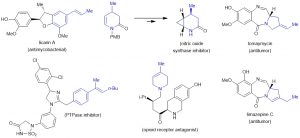
A research team led by Prof KOH Ming Joo, from the Department of Chemistry, NUS has devised a new olefin isomerisation technique in which catalytic amounts of an appropriate earth-abundant iron-based complex, a base and a boryl compound are employed to promote efficient and controllable alkene transposition (see Figure 1). This method can be used for both terminal and internal alkene substrates. Mechanistic studies by the team revealed that these chemical transformations are likely to proceed through a catalytic iron-hydride intermediate that induces C=C bond migration.
Prof Koh said, “The new catalytic regime provides a way to obtain structurally different products from a single substrate. Our team also found that iron-based catalysis can also be used to transform isomeric olefin mixtures, which are commonly found in petroleum-derived feedstock to a single alkene product for use by the petrochemical industry.” “This scientific advance not only highlights a new approach for alkene chain-walking. It also illustrates the viability of controlling where the C=C bond migrates even in substrates bearing at least two possible sites that may direct the olefin isomerisation. This has significant implications to facilitate the synthesis of unsaturated moieties embedded within biologically active compounds,” added Prof Koh. The research team plans to combine this new methodology with olefin addition reactions to develop novel functionalisation transformations.



Figure 1: Schematic showing the migration of the C=C bond in alkenes can be achieved using iron catalysis with less than stoichiometric amounts of a base and boryl reagent. [Credit: Journal of the American Chemical Society]

Figure 2: Schematic showing the ability of iron-based catalysis in promoting regioconvergent (produces a single compound from isomeric forms of it) and regiodivergent (produces structurally isomeric forms of the same compound) olefin isomerisation. [Credit: Journal of the American Chemical Society]

Figure 3: Schematic showing alkenes embedded within biologically active compounds and their precursors. [Credit: Journal of the American Chemical Society]
Read more about their new discovery here.
